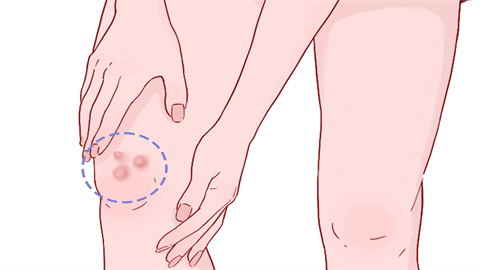What causes small lumps to appear on the legs?
Generally, small bumps appearing on the legs may be caused by dry skin, tight clothing, contact dermatitis, urticaria, psoriasis, or other reasons. Symptomatic treatment through general care and medication is usually required. If experiencing severe discomfort, it is recommended to seek timely medical consultation for targeted treatment. Detailed explanations are as follows:

1. Dry Skin
When the skin on the legs lacks sufficient moisture and oil protection, it may become rough, flaky, and develop small bumps, possibly accompanied by itching and tightness. It is recommended to keep the skin moisturized by using mild moisturizers or lotions and avoid harsh cleansers.
2. Tight Clothing
Tight clothing may hinder skin ventilation, causing the leg skin to become congested and develop small rashes, potentially accompanied by redness and itching. It is recommended to switch to loose, comfortable cotton clothing and avoid wearing tight clothing for prolonged periods.
3. Contact Dermatitis
Contact dermatitis may occur when the skin comes into contact with irritants or allergens, presenting as red patches, papules, or blisters on the legs. In addition to bumps on the skin, symptoms may include itching, burning, or pain. It is recommended to use medications such as hydrocortisone cream, fluocinonide acetate cream, or cetirizine hydrochloride tablets under a doctor's guidance.
4. Urticaria
Urticaria is a skin allergic reaction triggered by various factors such as food allergies, drug reactions, or insect bites. These triggers cause the release of chemicals like histamine in the body, leading to blood vessel dilation and tissue swelling that form wheals, possibly accompanied by systemic symptoms such as fever, headache, and nausea. It is recommended to use medications such as cetirizine hydrochloride oral solution, compound betamethasone and camphor cream, or calamine lotion under a doctor's guidance.
5. Psoriasis
Psoriasis is associated with abnormal activation of the immune system, leading to excessive proliferation of skin cells and inflammatory responses. This results in red patches covered with silvery-white scales on the skin surface. Besides skin symptoms, psoriasis may also be accompanied by joint pain and stiffness. It is recommended to follow medical advice to use medications such as calcipotriol ointment, tacalcitol ointment, or tazarotene gel to alleviate symptoms.
In daily life, it is recommended to keep the skin clean and dry and avoid using irritating cleansers, which helps maintain healthy skin.
References
[1] Zhang Sheng, Su Wei, Zhang Gaolei, et al. How to Correctly Identify and Manage Childhood Urticaria? [J]. Guide to Maternal and Child Health, 2025, 4(03): 12-14.
[2] Lu Jing. How to Prevent Contact Dermatitis [J]. Family Medicine, 2023, (11): 36-37.




